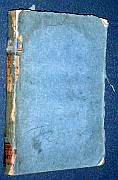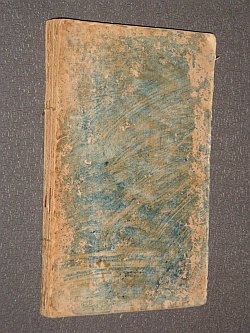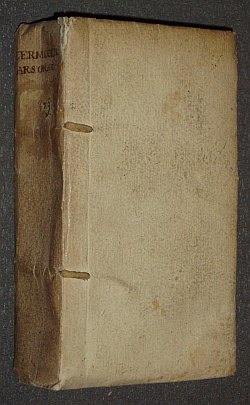It is not unusual for many collectors and researchers to come across old books retaining their original paper binding.
Centuries ago, the books were sold by the printer or the publisher. The client, who had requested a title, purchased it directly from the workshop; the book was in booklets tied up together with a string. Then, the client took the book to the bookbinder so that it would take its final form and become easy to handle. The client’s financial status along with his taste determined the final “look” of his book.
One of the cheapest bindings available is the limp vellum, a method that was very popular in Italy from the XVI to the XVIII centuries. The material most commonly used were cloth, leather and vellum in limp vellum and paper of course in paper bindings.
The paper binding was also a cheap and simple way to bind a book, using a light cardboard mostly in white or grey color. Generally, the same technique used for the limp vellum was applied. The booklets were sewn up in bands made from alumed leather, strings or rather tanned leather. The cardboard was folded twice in parallel; one fold at the edge of the spine and the parallel one some millimeters away on the plate. The bands were put through the cardboard in exactly the same way as with the vellum, having the same folds on the edges also. Sometimes, there remained these particular “lips” on the front edge as it was formatted with the vellum. It is also easy to see the characteristic protrusion of the boards around the edges, which is also seen on the solid wooden or heavy cardboard plates, even today. Another difference from the contemporary limp vellum bindings was the absence of the headbands and the glue on the spine. Practically, the paper cover was more like a “wrapping” held in place by the bands on the spine and the endpapers on the two sides.
This method of bookbinding was a favorite in Italy, and it was used also in Greek books printed in this country. It is to be considered as an “editor’s bookbinding”. However, in many popular editions there was no cardboard at all. Only light paper, many times colored, glued directly on the spine and sometimes on the glued endpapers. As years went by, many additions were applied in order to make this binding better looking or to repair scratches and slashes. Colored papers were glued directly on the cardboard, presenting repetitive patterns, or later pieces of paper were attached on the spine in order for the book to have better mechanical resistance. Many beautiful samples of paper bindings still exist, with nicely stamp decorated papers in a variety of colors and patterns.
We are not certain why this type of bookbinding was preferred. Was it a temporary one or not? Nevertheless, some rare samples of this type of binding expertly executed, with embossed decorations, indicate that this was the “final” binding of the book. However, it is predominantly believed that this kind of binding was not permanent, because no glue was used on the spine and the headbands. In those days, the headbands had a structural part and were a consolidated part of the bookbinding.
Generally speaking, paper book bindings are preserved in rather good condition and offer good protection to the block of the leaves as well. This type of binding is not common, because it was not considered elegant. That is why most of the originally paper bound books were rebound in later ages, when leather and vellum became the predominant materials. Despite this fact, paper binding, along with limp vellum binding, is preferred by the book restorers, for their simplicity and their proven reliability, for modern projects of book restoring.




{ 1 comment… read it below or add one }
I extend my warmest congratulations to the author of the article: very interesting!
{ 1 trackback }